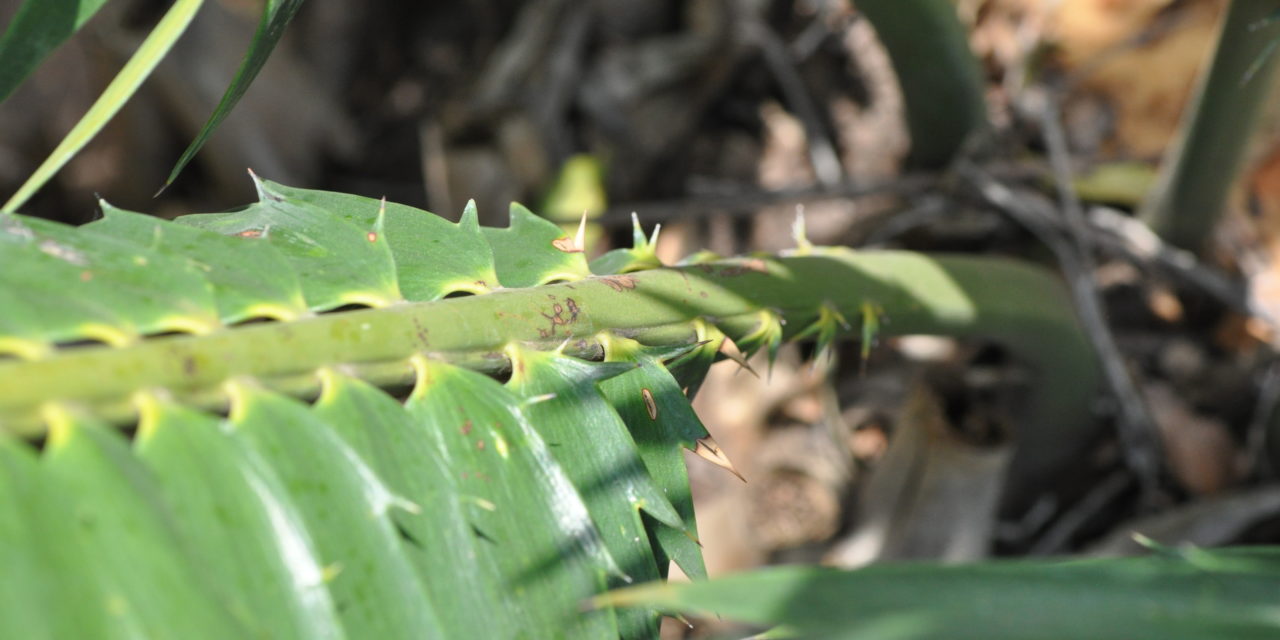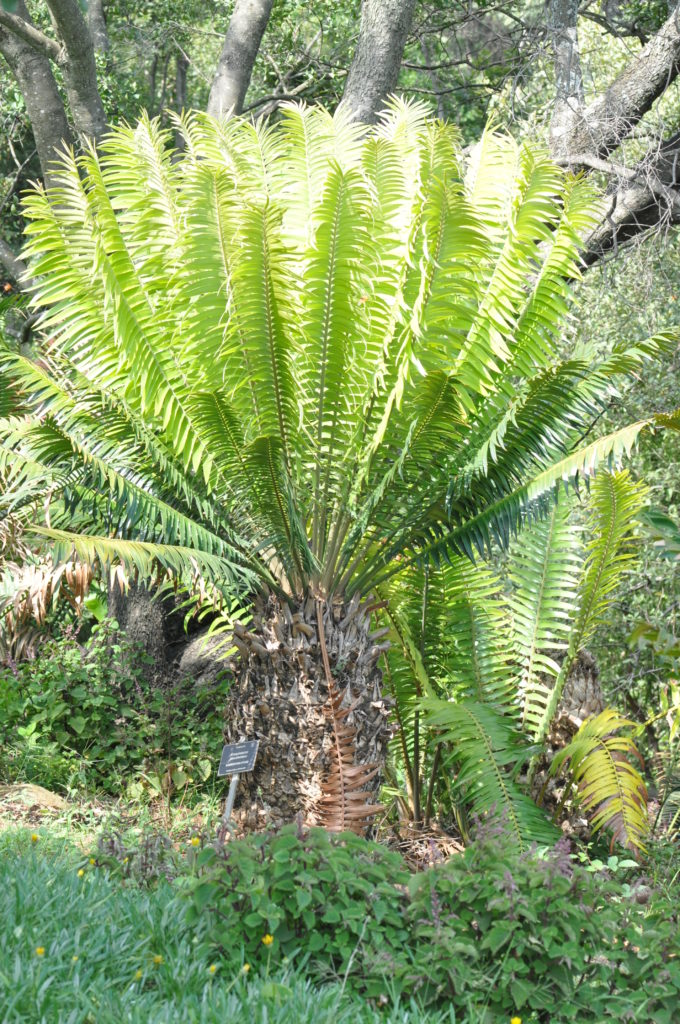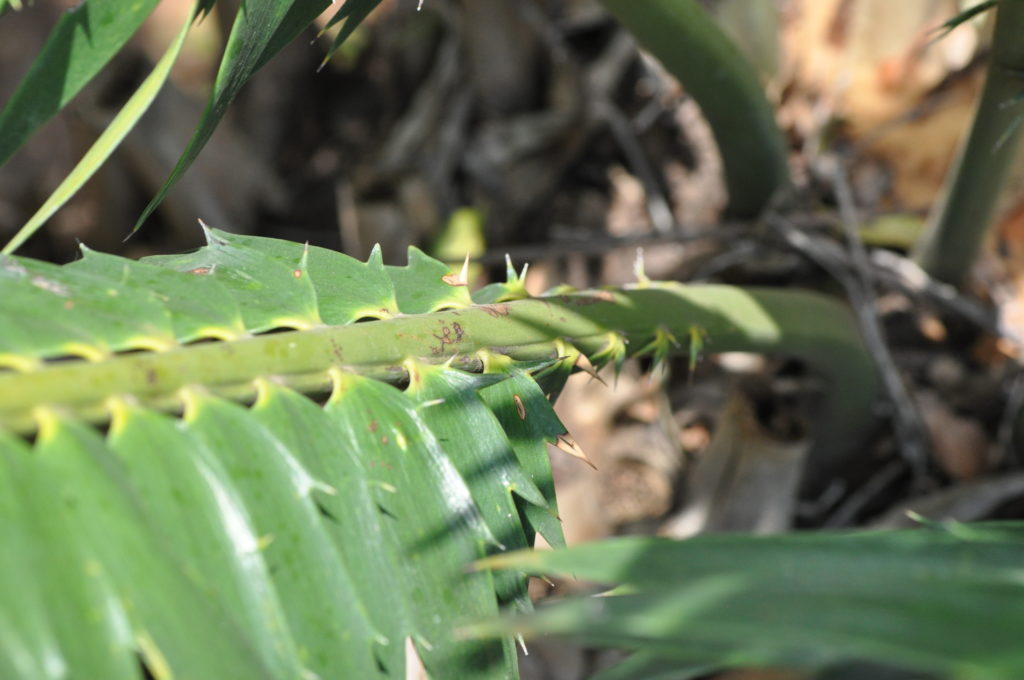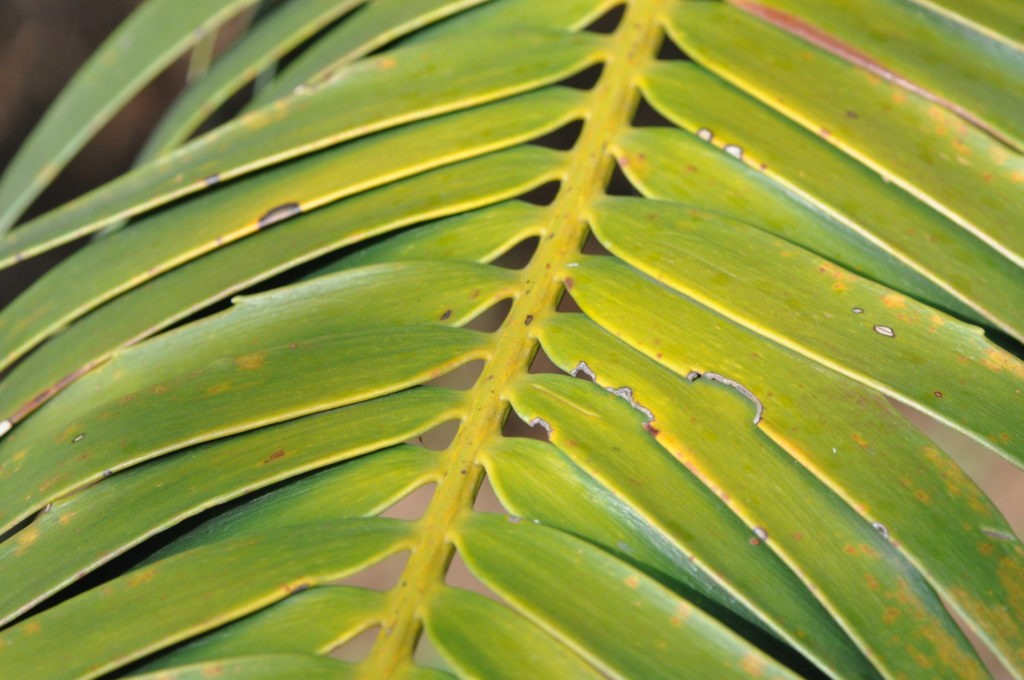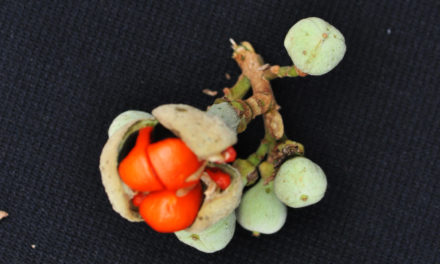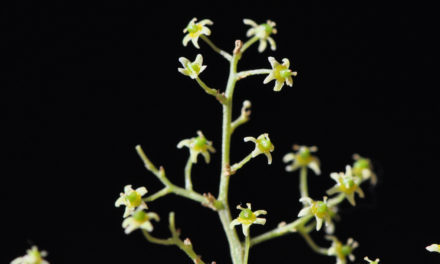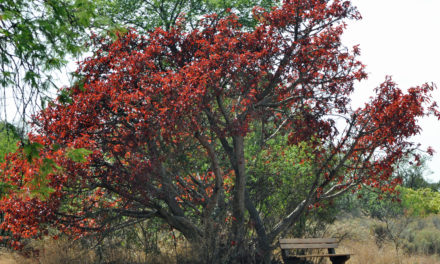General Info – summary
This rare, dioecious, endemic Tree has a trunk up to 7m x 70cm. Long, compound Leaves have leaflets increasingly reduced to spines near base. Central, spaced apart leaflets are the biggest. Petiolules are absent. Brown woolly hairs cover the centre of the crown. There are 1-5 hairy Male Cones, which are up to 60 x 16cm long. Wider golden yellow Female Cones to 50 x 25cm, have many large, bright red Seeds.
Description
Encephalartos paucidentatus
SA Tree No. 11.
Common names: (Afr) Barberton-broodboom, Broodboom. (Eng) Barberton Cycad, Cycad. (siSwati) Ligebeleweni, Sijekwane.
Family: Zamiaceae. This family is part of the major group: Gymnosperms. Zamiaceae are usually cone-bearing plants producing naked seeds and include Ginkgo (in China), Cycads, Conifers (e.g., pine trees) and Gnetophytes: e.g., the unique Welwitschia mirabilis (tweeblaarkanniedood) are not wind pollinated and found in the deserts of western Namibia and southern Angola. Members of the gymnosperm family Zamiaceae have no flowers or fruit and the seeds are often contained in Cones. This family has 8 genera, including the Genus Encephalartos, which contains all species of cycads.
Name derivation: Encephalartos – within-head-bread: referring to the starchy bread that can be made from the pith of the inner trunk. panucidentatus – few teeth – referring to the leaflets. All cycads fall into the genus Encephalartos, which includes some of the most primitive living Gymnosperms. The gymnosperm family Zamiaceae has 9 genera including Encephalartos (cycads). The African plants in the genus Encephalartos include about 66 species and there are about 30 species in southern Africa.
Conservation Status: V U. (Vulnerable). 2009/10/31. (J.S. Donaldson). Habitat reduction (forestry, farming) and illegal harvesting compound the situation.
Conservation: National Status: V U. (Vulnerable). Assessment: 2009 (J.S. Donaldson). Habitat reduction (forestry, farming) and illegal harvesting compound the situation.
Tree
Species of Encephalartos (Cycads) are only superficially palm or fern like and are usually unbranched. The cycad tap Root is usually soon replaced by lateral roots, which become woody. Cycads have Coralloid Roots that contain symbiotic cyanobacteria (blue-green algae) that fix atmospheric nitrogen. Through a process of complex biological pathways, the cyanobacteria convert atmospheric molecular nitrogen into compounds such as ammonia, and amino acids needed by the cycads.
Encephalartos paucidentatus is a woody Tree that is usually unbranched and has a trunk up to 7m high and 70cm wide with a large pith (usually the soft spongy central area of the stem). The spreading Crown has a diameter of up to 5m and a brown woolly centre. The trunk is straight, and stems may grow close to or along the ground without establishing roots. Up to 5 additional stems may arise at or close to the tree base.
- 304. 2015/02/24 Walter Sisulu NBG. Photo David Becking.
Leaves
Cycads are unique Gymnosperms with evergreen, pinnately compound Leaves and eventually only leaf scars remain on the trunk once the blade and petiole (leaf stalk) fall. Unlike other members of the family Zamiaceae, the cycads have Leaflets that lack a central Midrib (central vein). The hard leaflets do not bend easily and the Veins are parallel. Stomata (structure utilising 2 guard cells that, unlike lenticels, can control gaseous exchange) are present on the lower surface and may occur above. Cycads are unique Gymnosperms with pinnately compound leaves (leaflets arranged along either side of the leaf rachis, the central stalk, like a feather – (photo 304 under Tree). The evergreen pinnately compound leaves (have leaflets arranged along either side of the leaf rachis, the central stalk, like a feather). These leaves are persistent – lasting more than a year and tend to droop. Plants growing in shade tend to have longer leaves. Petioles (leaf stalks) remain on the trunk for a while after the leaf blades have fallen. They eventually fall – leaving a distinctive scar. Petiolules (leaflet stalks) are absent.
On this plant, the straight or slightly curved leaves are up to 2,3m long and possess glossy bright green or yellowish green (photo 309), lanceolate Leaflets. The central leaflets are spaced apart but those closer to the leaf apex are less so They are often droop slightly downwards and are broad, straight or slightly curved. The bent down central leaflets are the biggest – up to 25 x 3,2cm. The leaflet apex tapers and the base is broad. Leaflets point upwards at the end of the leaf and those further away bend downwards. Twenty or more distinctly parallel raised Veins are visible here and are easier to see with a hand lens. Leaflet size gradually decreases towards the base resulting in those closest to the petiole being reduced to prickles. On the lower surface brown wool is visible. The up to 20cm long Petioles (leaf stalks) are initially green but become yellow. The under surface of a leaflet and the petiole may be hairy – especially when young. There are few or no prickles. When present, prickles occur on either side of the leaflet margins (photo 309).
- 309. 2015/02/24 Walter Sisulu NBG. Photo David Becking.
- 306. 2015/02/24 Walter Sisulu NBG. Photo David Becking.
Cones
Gymnosperms have unenclosed or naked seeds. They have no flowers or fruit, and the seeds are often contained in cones. In the Angiosperms (flowering plants), the seeds are enclosed in an ovary. In the Gymnosperms, there are 2 modes of fertilization. In all the Cycads (including Encephalartos) and the single extant (not extinct) species Ginkgo biloba, the male cones produce motile Sperms, which do not move along a pollen tube. The remaining members of the Gymnosperms all have non-motile sperm with no flagella and sperm are moved along a Pollen tube to the egg. All cycads are dioecious with male and female Cones developing on separate plants.
On this tree, the cones become a golden brown and they develop in the centre of the terminal leaf whorls. Up to 5 yellow and broadly cylindrical Male cones develop on short stalks. Each is up to 60 x 15cm and initially covered with brown hairs. Up to 5 wider, golden yellow, large, stalked Female cones may develop – each up to 50 x 25cm. They are hairy only when young and produce naked ovules (no ovary). The tree is insect pollinated and beetles (Coleoptera) have been identified as the most common pollinators of cycads. At maturity, Seeds are released when the Female cones disintegrate. All seeds produce carcinogenic and neurotoxic glycosides (cycasins). These are poisonous to mammals – including man. These poisonous, red, seeds are large – about 4 x 2,5cm.
Distribution & Ecology
This Tree is a southern African Endemic (restricted to a particular geographic location). Trees only occur in the mountains of eastern Mpumalanga near Barberton and in north-west Swaziland. Sub-populations have declined due to afforestation, illegal collections and usage of the land for agriculture. These cycads grow on mountain slopes, in mist belts and along valleys close to streams and are usually located in the altitude range of 1 000 – 1 700m. They are visible on the escarpment to the North of God’s Window. Birds, monkeys and baboons collect the Fruit. After they consume the outer covering, these animals discard the seeds, thus dispersing them. Cycads have Coralloid Roots that contain symbiotic cyanobacteria (blue-green algae) that fix atmospheric nitrogen for the trees.
Ethnobotany
This is a popular, now threatened cycad and a permit is required for having one. These cycads require quite a lot of space. They are faster growing than most cycads and should be planted in frost-free areas and watered regularly. Choose the spot carefully because they do not relocate well. Seeds are poisonous and should be handled with gloves.
References
Boon, R. 2010. Pooley’s Trees of eastern South Africa. Flora and Fauna Publications Trust, Durban.
Coates Palgrave, M. 2002. Keith Coates Palgrave Trees of Southern Africa, edn 3. Struik, Cape Town.
Donaldson, J.S. 2009. Encephalartos paucidentatus Stapf & Burtt Davy. National Assessment: Red List of South African Plants version 2020.1. Accessed on 2023/04/19.
Lawrence, G. H. M, 1951. Taxonomy of Vascular Plants. The Macmillan Company, New York. Tenth Printing 1965.
Palmer, E. & Pitman, N. 1972. Trees of southern Africa. Balkema, Amsterdam, Cape Town.
Schmidt, S. Lotter, M. & McCleland, W. 2002. Trees and Shrubs of Mpumalanga and the Kruger National Park.
http://www.plantzafrica.com/plantefg/encephpaucid.htm
https://en.wikipedia.org/wiki/Encephalartos_paucidentatus
http://pza.sanbi.org/encephalartos-paucidentatus
http://biodiversityadvisor.sanbi.org/wp-content/uploads/sanbi-identify-it/plants/encephalartos.htm
http://www.theplantlist.org/browse/G/Zamiaceae/
https://www.diffen.com/difference/Angiosperms_vs_Gymnosperms
http://www.theplantlist.org/browse/G/Zamiaceae/
Insect pollination in the African cycad Encephalartos friderici-guilielmi Lehm – ScienceDirect

